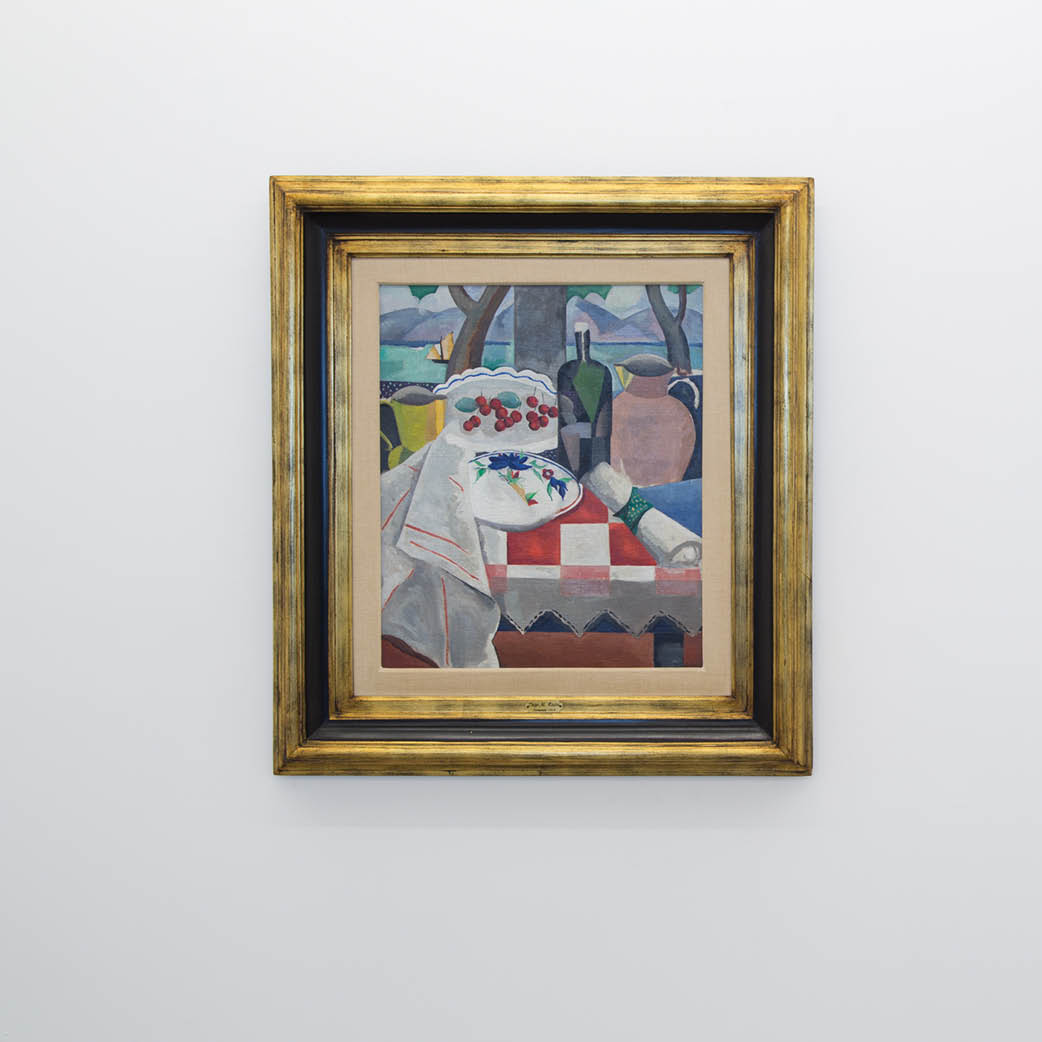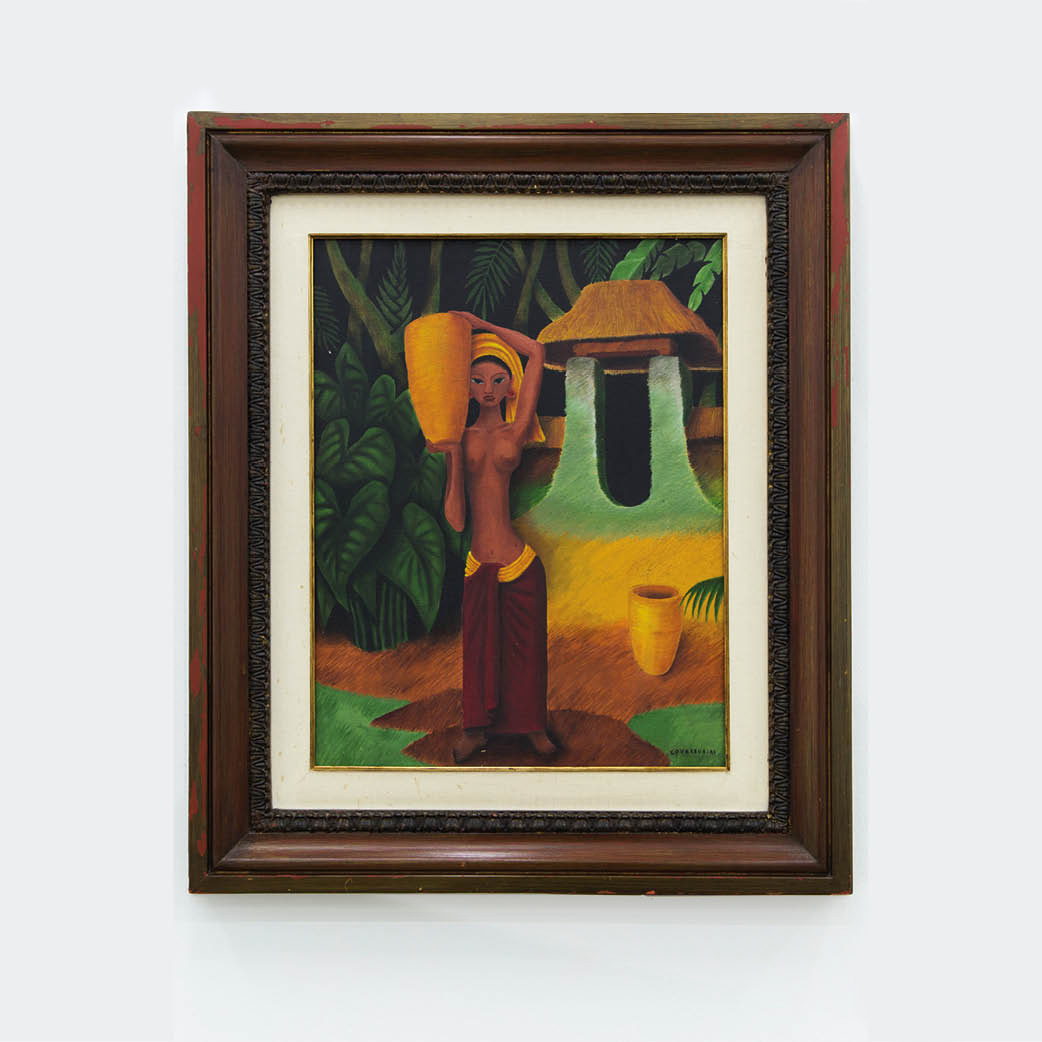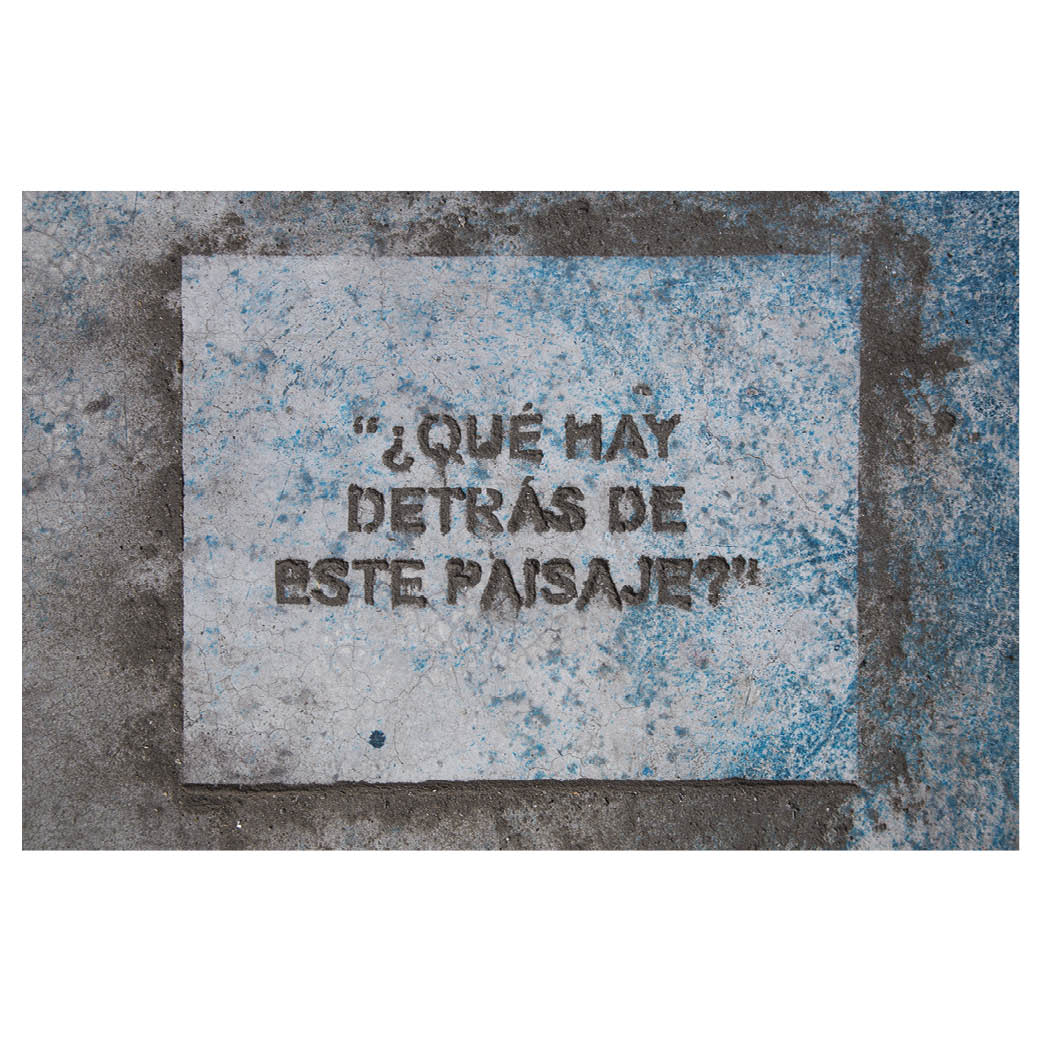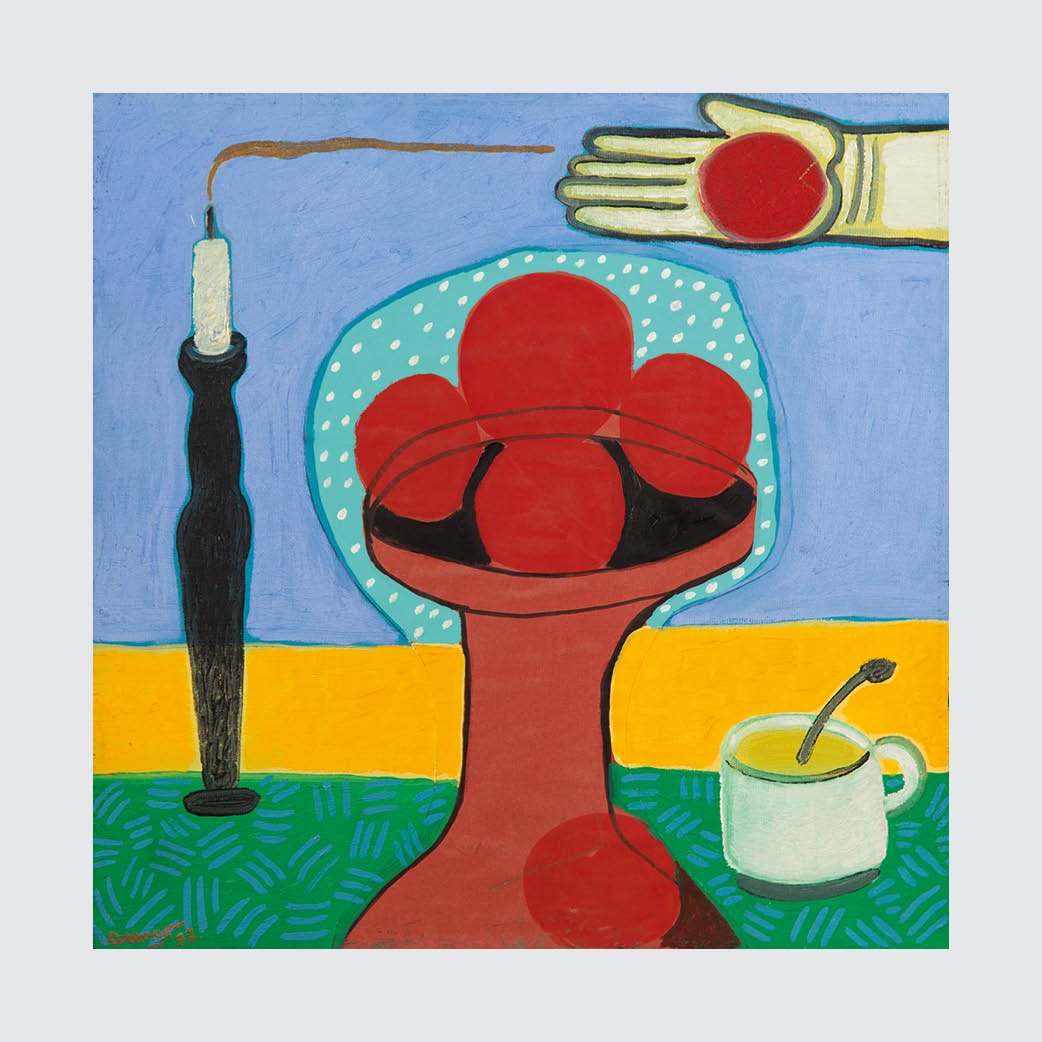Comisiones
a destiempo
Still Life with Landscape
Pamela Desjardins
Pamela Desjardins
Curator, cultural manager, teacher and researcher. She has been curator of FLORA ars + natura, Bogotá, Colombia, and associate curator of the Museo Tamayoin Mexico City. He was part of the Independent Studies Program of MACBA, Barcelona, Spain, between 2012-2013.
The starting point for this text i a series of works from the ESPAC collection.
The starting point for this text i a series of works from the ESPAC collection.
Mother Nature, turn me into a tree [...]
and in the silent poetry of the landscape,
instead of thoughts I shall bear flowers
.
Man Césped1
and in the silent poetry of the landscape,
instead of thoughts I shall bear flowers
.
Man Césped1
The arrangement of the world and how we relate to everything that inhabits it, is—to a large extent—founded on the division between Nature and culture.2 This separation, that places man and his “exceptional” cognitive capacities—reason and conscience—at the center, configures the world from an anthropocentric perspective, which bestows value to both the human and the nonhuman. I say “man” not as a synonym of “human,” but to refer to the gender-generic designation: a man with a series of particularities, whose main trait is his whiteness.

Diego Rivera, Naturaleza muerta cubista con paisaje, ca. 1915. Óleo sobre tela, 62 x 52cm
Thus, this anthropocentric configuration distinguishes between the spheres of the human and the nonhuman, naming the latter Nature: living and nonliving subjects such as plants, animals, rivers, mountains, rocks, etcetera. However, as the ecofeminist philosopher Val Plumwood points out, in the past, forms that were considered less ideal or more rudimentary than the human— such as women and people who were racialized for allegedly being “backward” or “primitive”—were considered part of the sphere of nature, example of an earlier and more animal stage in the development of the human specie. In this way, the domain of the human was reserved for a truthful or ideal representation that identified with reason.3 These minority subjects—associated with the instinctual and emotional as opposed to the rational—along with nature, conform that which, from a reductionist perspective, has been designated as the other or otherness. That is, what is different from the “true” human. Many of these connotations still prevail in machismo, racism and classism.
![]()
An emblematic image of anthropocentric thought is Leonardo Da Vinci’s Vitruvian Man from 1492, which depicts a male figure of ideal proportions, perfectly centered within a circle, his arms and legs extended: the center and the measure of everything. Anthropocentric humanism, predominantly structured during the Renaissance, reinforces the role of reason and the development of science by means of which it observes, defines, organizes and explains the world. When instrumental reason is placed at the center, it separates and distances Nature, understood as its antithesis. That is, as a set of objects—animate and inanimate—without reason and consciousness, whose only form of agency to survive the environment is instinct. And I say “objects” and not “subjects,” since that is how they are conceived: as mere things or resources.
The academic teaching of art follows the ideal proportions and distances between the parts indicated in the Vitruvian Man. This ideal and centered man has determined the way of looking, representing, measuring and valuing the world from a universally Western perspective. Hence, from the standpoint of anthropocentric humanism, the appraisal of the nonhuman is determined by instrumental reason that, as Eduardo Gudynas states, is guided by a manner of “interpreting and feeling the environment in function to human’s own needs and wishes.” This way of linking us to the world is “based on utility or personal benefit, whether direct or indirect [...], such as the aesthetic enjoyment of a landscape, exploiting a mining deposit, or modifying a landscape to turn it into farmland4

Miguel Covarrubias
Mujer con jarra en Fiji, 1945.
Óleo sobre tela
62 × 48 cm.
An emblematic image of anthropocentric thought is Leonardo Da Vinci’s Vitruvian Man from 1492, which depicts a male figure of ideal proportions, perfectly centered within a circle, his arms and legs extended: the center and the measure of everything. Anthropocentric humanism, predominantly structured during the Renaissance, reinforces the role of reason and the development of science by means of which it observes, defines, organizes and explains the world. When instrumental reason is placed at the center, it separates and distances Nature, understood as its antithesis. That is, as a set of objects—animate and inanimate—without reason and consciousness, whose only form of agency to survive the environment is instinct. And I say “objects” and not “subjects,” since that is how they are conceived: as mere things or resources.
Alejandro Arango
Naturaleza muerta, 1998.
Técnica mixta sobre tela
40 × 40 cm.
The academic teaching of art follows the ideal proportions and distances between the parts indicated in the Vitruvian Man. This ideal and centered man has determined the way of looking, representing, measuring and valuing the world from a universally Western perspective. Hence, from the standpoint of anthropocentric humanism, the appraisal of the nonhuman is determined by instrumental reason that, as Eduardo Gudynas states, is guided by a manner of “interpreting and feeling the environment in function to human’s own needs and wishes.” This way of linking us to the world is “based on utility or personal benefit, whether direct or indirect [...], such as the aesthetic enjoyment of a landscape, exploiting a mining deposit, or modifying a landscape to turn it into farmland4


︎︎︎ Abelardo López. Valle de Tlacolula, 2008. Óleo sobre tela, 100 × 200 cm.
︎︎︎ Chantal Peñalosa. Tenemos muchos recuerdos de ese lugar, lo único que norecordamos es el día que dejamos de ir. (“¿Qué hay detrás de este paisaje?”), 2016. Impresión de inyección de tinta sobre papel de algodón, 35 × 55.5 cm
This utilitarian conception, also separated from the nonhuman, is present in Nature when it is understood as a landscape to be admired, intervened, or as a resource for the production of goods. Pictorial genres like the still life and the landscape are examples of this. The first case is a representation of that which has entered the human sphere, specifically domestic space, such as fruits that no longer hang from trees, flowers that have been picked to be placed inside a vase or dead animals, which coexist with objects created by humanity. On the other hand, since its conception, the landscape is a fragment of a territory that is denoted by its visual and aesthetic qualities, in order to be admired as a spectacle from a determined place. For a landscape to exist, a subject that observes and an object that is observed are necessary. Therefore, for the terrain to be named, an assessment of its specificities is necessary.
Although, there are various “types” of landscapes represented in the pictorial tradition—such as the natural, the rural or the urban—, which are defined by levels of human intervention, their first purport is related to “pure” Nature, unattainable, inaccessible and sublime; uninhabited by the human and therefore, distinct and separate from it. The landscape as a pictorial genre has the function of reaffirming the utilitarian appraisal, in this case aesthetic, on a fragment of a territory.
Néstor Quiñones
La inverosímil proyección de lo humano, 2013.
Técnica mixta sobre tela
25 × 20 cm.
From an anthropocentric stand point, culture—understood as a set of manifestations, consequence of intellectual and sensitive faculties exclusive of humans—locates art as one of its highest expressions. The division between Nature and culture is evidenced not only of how Nature is represented, but also of how it is incarnated in the spaces that safeguard artworks, such as museums.
Museums are places that cannot be accessed by other forms of life. Not only because animals or plants are unauthorized to appreciate or understand art, but because they present a threat to the “life” of the works. Light, humidity and temperature are the enemies of museums and their storage rooms. They generate the necessary conditions for the reproduction of fungi, mold, plants and insects; basically “plagues” that would destroy art and end “culture.”
In these aseptic spaces constant sterilization efforts are made in order to stop the reproduction of living things. Preserving the integrity of art objects entails preventing the proliferation of other organisms. We cover certain light entrances, we turn on the air conditioners to keep the temperature below 86º and the humidity to less than 50%, we check that the entrances to the warehouses are closed, that there are no leakages and we fumigate regularly. It is not by chance that this campaign against the reproduction of life in museum spaces resonates with the phonetic relationship that Theodor Adorno establishes between the words “museum” and “mausoleum” by suggesting that “museums are like the family sepulchers of works of art.” 5
Los Carpinteros
Mundo de agua, 2004.
Acuarela
225 × 117 cm.
As this author explains, the word museal “describes objects with which the observer no longer has a vital relationship and are in the process of dying. They owe their preservation more to historical respect than to the needs of the present.”6
Shouldn't we perhaps stop aspiring for immaculate institutions that allocate budgets to safeguard and preserve the “life” of works instead of promoting the reproduction of other lives? To let the leaks that already lurk the cellars of many museums enlarge in order to allow water, humidity and light to enter, so that fungi, mold and plants may grow, and insects may feed on the paper pulp and the termites on the wooden frames?
The anthropocentric view generates and sustains a dominant cultural paradigm. Not only has it instrumentalized human and nonhuman subjects from a utilitarian condition, but has also instrumentalized the “potency of creation”—as Suely Rolnik sustains—neutralizing artistic practices by reducing them to the “mere exercise of creativity disassociated of the ethical function of giving the body what life announces.” When creativity—one of the indispensable capacities for creative work—is disassociated from the knowing of the body (saber-del-cuerpo), “it ceases to act in tune with what life demands of it and becomes sterile, deviating from its ethical function.”.7
Francisco «Taka» Fernández
Manglar, 2013.
Técnica mixta sobre tela
191 × 260 cm.
At the precipice of civilization’s collapse, questions of how to work from artistic practices and institutions become inevitable. Perhaps, the turn of the anthropocentric gaze towards biocentric ethics allows us agents who work in the artistic field—artists, curators, administrators, educators, researchers—the opportunity to begin to question and rearticulate our practices. The modern zeitgeist—that birthed the genres of the still life and the landscape—still persistently reaffirms a separation between Nature and culture.
Perhaps, a way to begin to let go of this decimononic burden is to stop creating objects and spaces that in order to prevail through time, constantly avoid light, humidity and temperature. And instead, begin to generate more—conceptual, material and affective—tools, oriented towards preserving, protecting and reproducing the necessary conditions for human and nonhuman life.
1. Man Césped is the pseudonym of the Bolivian poet and storyteller Manuel Céspedes Anzoleaga (Sucre, 1874 - Cochabamba, 1932), who conceived of other living beings as his siblings, which is why he was associated with ecological transcendentalism and wished to turn to nature upon his death. A ceiba tree now grows in the exact spot where his remains were buried.
2. In accordance with Eduardo Gudynas’s position, I capitalize Nature to refer to “an environment, as a whole or system, where the original landscapes, fauna and flora prevail (or wild or with intermediate degrees of human intervention),” but also to “differentiate the word nature understood as the essence or property of something,” in Eduardo Gudynas, Derechos de la naturaleza. Ética biocéntrica y políticas ambientales [Rights of nature. Biocentric ethics and environmental policies], (Buenos Aires: Tinta Limón, 2015), p.11.
3. Val Plumwood, "Decolonizing relationships with nature" in William Adams and Martin Mulligan (eds.), Decolonizing Nature: Strategies for Conservation in a Post-colonial Era (London: Earthscan, 2003).
4. Eduardo Gudynas, Derechos de la naturaleza. Ética biocéntrica y políticas ambientales [Rights of nature. Biocentric ethics and environmental policies], (Buenos Aires: Tinta Limón, 2015), p.21.
5. Theodor W. Adorno “Valery Proust Museum”, citado en Douglas Crimp, “Sobre las ruinas del museo”, en Hal Foster (coord.) La posmodernidad.
6. Ibid.
2. In accordance with Eduardo Gudynas’s position, I capitalize Nature to refer to “an environment, as a whole or system, where the original landscapes, fauna and flora prevail (or wild or with intermediate degrees of human intervention),” but also to “differentiate the word nature understood as the essence or property of something,” in Eduardo Gudynas, Derechos de la naturaleza. Ética biocéntrica y políticas ambientales [Rights of nature. Biocentric ethics and environmental policies], (Buenos Aires: Tinta Limón, 2015), p.11.
3. Val Plumwood, "Decolonizing relationships with nature" in William Adams and Martin Mulligan (eds.), Decolonizing Nature: Strategies for Conservation in a Post-colonial Era (London: Earthscan, 2003).
4. Eduardo Gudynas, Derechos de la naturaleza. Ética biocéntrica y políticas ambientales [Rights of nature. Biocentric ethics and environmental policies], (Buenos Aires: Tinta Limón, 2015), p.21.
5. Theodor W. Adorno “Valery Proust Museum”, citado en Douglas Crimp, “Sobre las ruinas del museo”, en Hal Foster (coord.) La posmodernidad.
6. Ibid.



